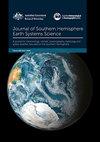新一代澳大利亚社区气候与地球系统模拟器耦合模式ACCESS-CM2的配置与启动
IF 3.6
4区 地球科学
Q1 Earth and Planetary Sciences
引用次数: 108
摘要
澳大利亚社区气候和地球系统模拟器耦合模型ACCESS-CM2的新版本已经开发出来,用于广泛的气候模拟研究和应用。特别是ACCESS-CM2是澳大利亚对世界气候研究计划耦合模式比较项目第6阶段(CMIP6)的贡献之一。与我们提交CMIP5时使用的ACCESS1.3模型相比,所有模型组件以及耦合框架(OASIS3-MCT)和实验控制系统(Rose/Cylc)都进行了升级。分量模式为:UM10.6 GA7.1用于大气,CABLE2.5用于陆地表面,MOM5用于海洋,CICE5.1.2用于海冰。本文描述了ACCESS-CM2的模型配置,记录了实验设置,并与(重建)观测结果和ACCESS1.3结果进行比较,评估了模型在工业化前自旋模拟中的性能。虽然两代ACCESS耦合模式的性能在很大程度上具有可比性,但ACCESS- cm2表现出更好的全球水文平衡,更真实的海洋水特性(就空间分布而言)和南大洋经向翻转环流,但对南极海冰的模拟较差,大气顶部的能量不平衡较大。这种能量不平衡反映了自旋上升时期全球海洋明显变暖的趋势。本文章由计算机程序翻译,如有差异,请以英文原文为准。
Configuration and spin-up of ACCESS-CM2, the new generation Australian Community Climate and Earth System Simulator Coupled Model
A new version of the Australian Community Climate and Earth System Simulator coupled model, ACCESS-CM2, has been developed for a wide range of climate modelling research and applications. In particular, ACCESS-CM2 is one of Australia’s contributions to the World Climate Research Programme’s Coupled Model Intercomparison Project Phase 6 (CMIP6). Compared with the ACCESS1.3 model used for our CMIP5 submission, all model components have been upgraded as well as the coupling framework (OASIS3-MCT) and experiment control system (Rose/Cylc). The component models are: UM10.6 GA7.1 for the atmosphere, CABLE2.5 for the land surface, MOM5 for the ocean, and CICE5.1.2 for the sea ice. This paper describes the model configuration of ACCESS-CM2, documents the experimental set up, and assesses the model performance for the preindustrial spin-up simulation in comparison against (reconstructed) observations and ACCESS1.3 results. While the performance of the two generations of the ACCESS coupled model is largely comparable, ACCESS-CM2 shows better global hydrological balance, more realistic ocean water properties (in terms of spatial distribution) and meridional overturning circulation in the Southern Ocean but a poorer simulation of the Antarctic sea ice and a larger energy imbalance at the top of atmosphere. This energy imbalance reflects a noticeable warming trend of the global ocean over the spin-up period.
求助全文
通过发布文献求助,成功后即可免费获取论文全文。
去求助
来源期刊

Journal of Southern Hemisphere Earth Systems Science
Earth and Planetary Sciences-Oceanography
CiteScore
8.10
自引率
8.30%
发文量
0
审稿时长
>12 weeks
期刊介绍:
The Journal of Southern Hemisphere Earth Systems Science (JSHESS) publishes broad areas of research with a distinct emphasis on the Southern Hemisphere. The scope of the Journal encompasses the study of the mean state, variability and change of the atmosphere, oceans, and land surface, including the cryosphere, from hemispheric to regional scales.
general circulation of the atmosphere and oceans,
climate change and variability ,
climate impacts,
climate modelling ,
past change in the climate system including palaeoclimate variability,
atmospheric dynamics,
synoptic meteorology,
mesoscale meteorology and severe weather,
tropical meteorology,
observation systems,
remote sensing of atmospheric, oceanic and land surface processes,
weather, climate and ocean prediction,
atmospheric and oceanic composition and chemistry,
physical oceanography,
air‐sea interactions,
coastal zone processes,
hydrology,
cryosphere‐atmosphere interactions,
land surface‐atmosphere interactions,
space weather, including impacts and mitigation on technology,
ionospheric, magnetospheric, auroral and space physics,
data assimilation applied to the above subject areas .
Authors are encouraged to contact the Editor for specific advice on whether the subject matter of a proposed submission is appropriate for the Journal of Southern Hemisphere Earth Systems Science.
 求助内容:
求助内容: 应助结果提醒方式:
应助结果提醒方式:


